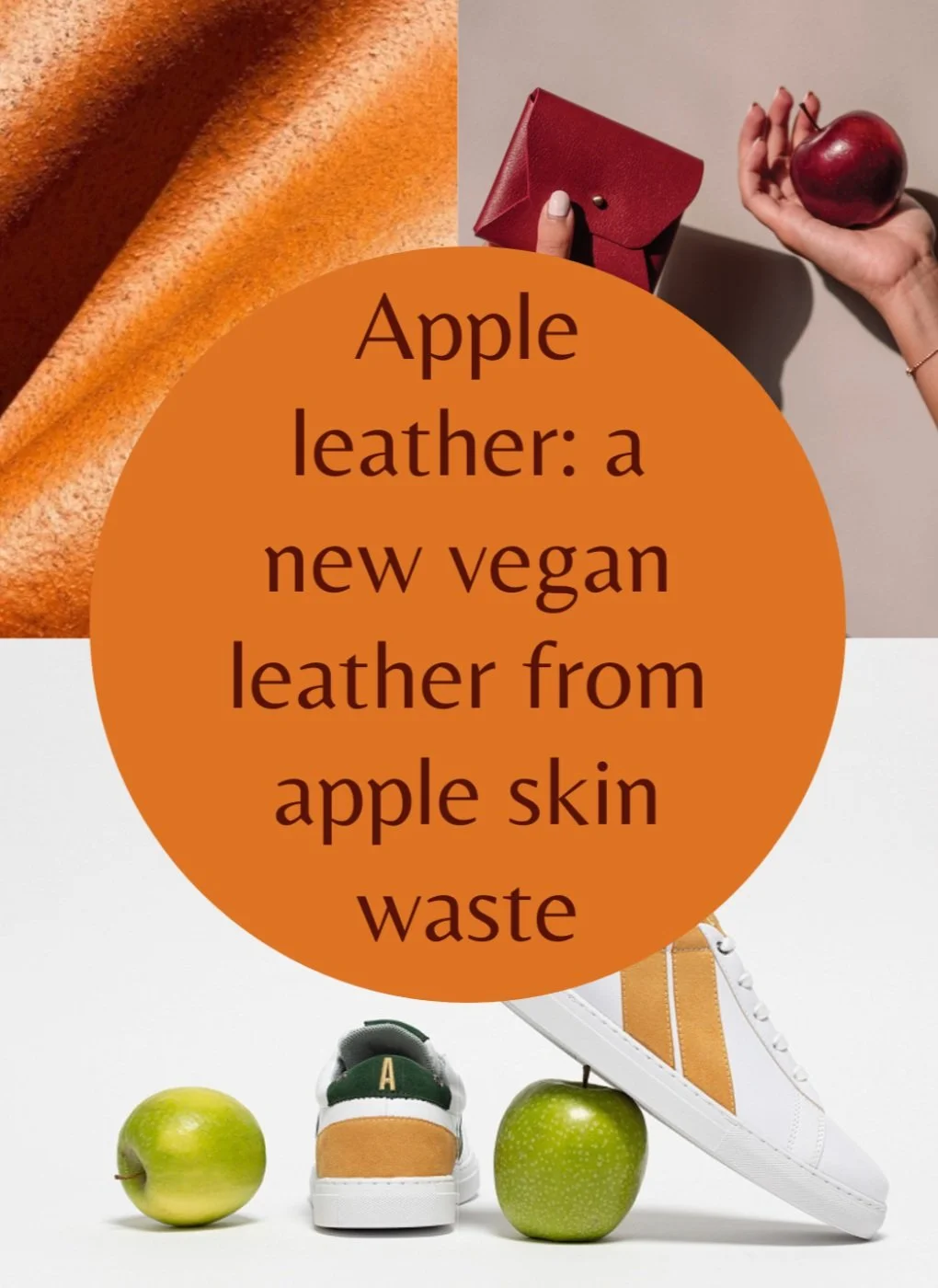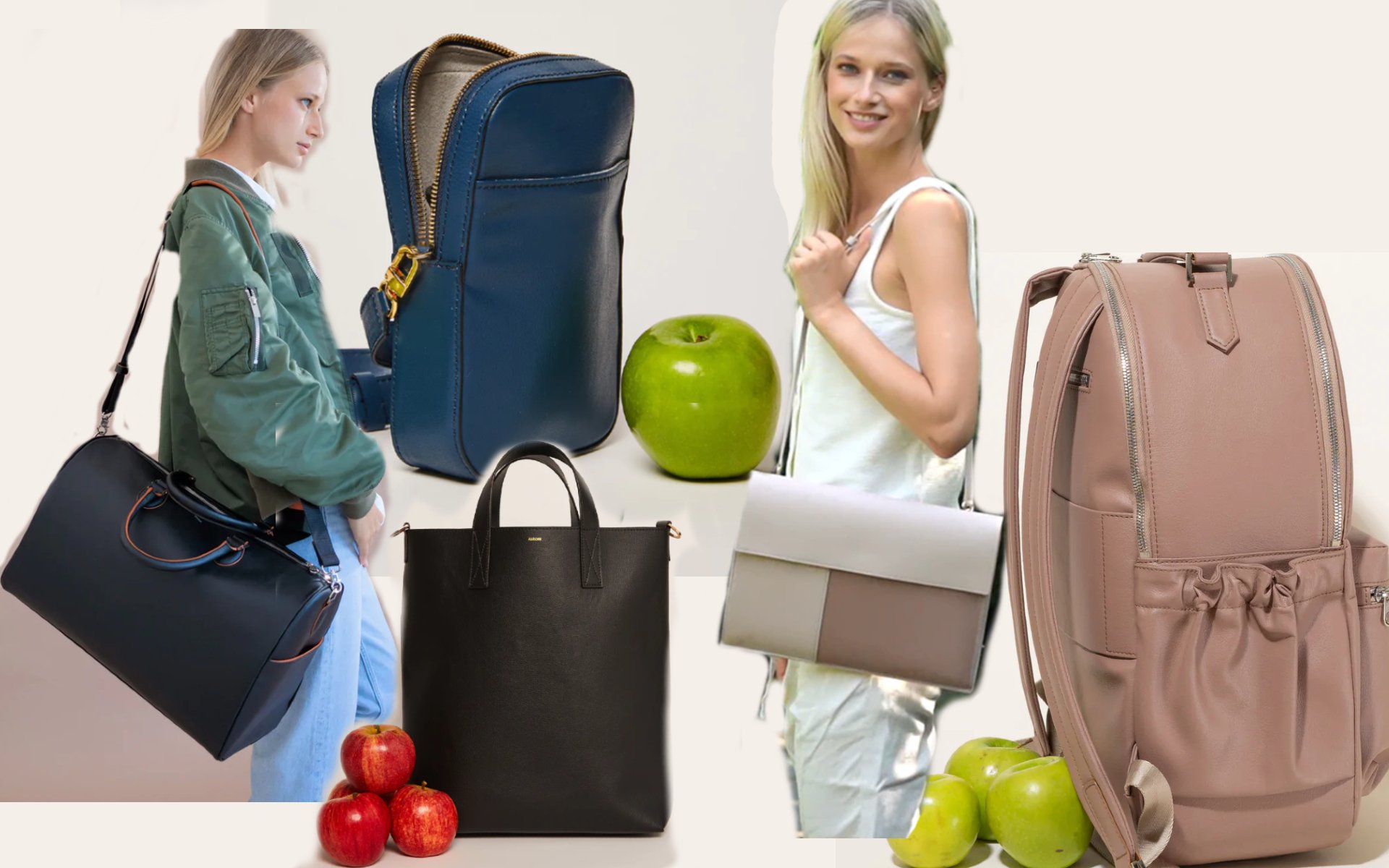A few months ago, I wrote a post highlighting designers and brands with environmentally friendly ranges using sustainable materials and textiles. Since then, I have discovered even more brands and designers working to be more environmentally sustainable. In this post, I will specifically highlight brands that use apple waste to make “leather” accessories.
So why apples?
Apples are considered one of the most popular fruits. So it is a no-brainer that apples are among the most produced and the most consumed fruit in the US. According to a USDA study, each person consumes about 10.7 pounds of fresh apples and 1.6 gallons of apple juice. Due to the fruit’s widespread popularity, China, the EU and the US produce about 75% of the world’s production.
With large production and consumption, comes sizable waste. Approximately 3.7 trillion apples are thrown out annually. Four percent of apples are tossed out by customers at home; 9% are tossed out from retail to customer level; and 4% are loss from farm-to-retail. Although the numbers are astounding, discarded apples are plentiful, and because of the fibrous composition of apple skin, it’s waste can easily be upcycled into valuable products.
Fruit waste from discarded apple peels contains 50% of the fiber in an apple. The peels in combination with bio-contents and water-based PU (created from apples dried into fine powder that is blended with a kind of resin) undergo a proprietary process which eventually yields an eco-friendly alternative to cow skin leather that is innovative and sustainable. Producing the apple “leather” is less harmful and environmentally impactful because it requires fewer fossil fuels. Unfortunately, however, this innovative and ethically sourced alternative material isn’t completely biodegradable. As mentioned, the leather may be deemed high quality synthetic because it is 50% derived from fossil fuels.
Designers & Brands
Brandon Blackwood is an emerging, top young designer of color. He recently received his first CDFA for American Accessory Designer of the Year 2022. The awards come off the tail of his successful release of the “End Systemic Racism (ESR)” canvas totes. The bags were a direct answer to the 2020 protest against racial injustices and police brutality. He is also board chair of the Brandon Blackwood Foundation, which focuses on enrichment by “creating through education, philanthropy and activism”, hoping to counteract systemic racism. The profits from all tote bags purchased from the ESR Collections will benefit the Brandon Blackwood Foundation.
Beyond being a socially conscious designer, Brandon Blackwood is working to foster an ethically sustainable brand. He sources recycled denim fabrics from pre- and post-consumer denim scraps and repurposes them into new denim. He uses recycled canvas sourced from pre- and post-consumer denim textile scraps from the brand’s handbags and clothes. The brand uses recycled leather, which is a hybrid of real, genuine and vegan leather scraps used by the company. This allows the brand to produce their collections with no leather waste. Lastly, the brand uses a process that takes dehydrated apple seeds, stalks and apple skins blended with other materials to make a bio-based apple leather. So, when the customer selects an apple leather bag to purchase, it is at least 50% made from leftover fruits and vegetables.
Allégorie is a brand that I had no knowledge of prior to researching brands and designers that used apple leather. I have since learned many great things about this socially responsible and sustainable, women-led brand. Firstly, this brand is all about making an immensely positive impact on the planet by pushing the bounds of innovation for sustainable fashion. It was founded on the mission to help reduce food waste by transforming the excess food produce into high quality accessories.
The co-founders of Allégorie set out to start an eco-friendly accessory brand with a line of beautifully crafted sustainable fashion accessories. The “alternative leather” materials come from Japan, Italy and the Netherlands and Taiwan. The brand’s handbags, totes and backpacks are produced from the fruit leather of mangos and apples waste. The materials used to make their products are upcycled using discarded fruit from grocery stores and juice factories. Each backpack uses about 550 apples with bio-content, which makes up nearly 80% of the bag composition.
Aside from the positive environmental impact that the brand is fostering, Allégorie is socially sustainable. Founders follow the supply chain of their materials and fruit leathers back to their countries of origin. They visit facilities looking to cultivate personal connections with the artisans and makers collecting the fruit. Fair and competitively wages and benefits are also a top prior in the company. This environmental and socially sustainable brand is on the ground floor partnering with manufacturers who prioritize environmentally friendly guidelines such as: zero emission of hazardous chemicals, use green energy and net zero on water usage.
Samara is a beautiful conscious lifestyle brand that creates clothes and accessories from sustainable and innovative materials. The primary goal at SAMARA is to create a positive impact on the world and the fashion industry. Their collections are comprised of apple and vegan leather, recycled ocean plastics, organic cotton, bamboo and castor seeds. In the past, the brand experimented with sustainable materials that just didn’t fit because they lacked a premium feel, such as coconut husk and pineapple leather. Soon after, the brand found apple leather. Their “apple leather” is made from the waste by-products of the juicing industry at orchards in Europe.
The brand has broken their production process down to four simple steps: (1) Gather, which is simply collecting pulpy fiber from apple waste by-product, after it has been harvested, cleaned and juiced; (2) Dry or dehydrate apple pulp until it turns to powder; (3) Mix by combining the powder with PU; and (4) Roll the mixture and flattened it to form the “apple leather” material.
Although SAMARA isn’t entirely plant-based right now, the brand is working to innovate materials and processes that will ensure that their materials are sustainable and completely biodegradable.



